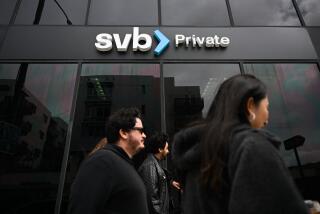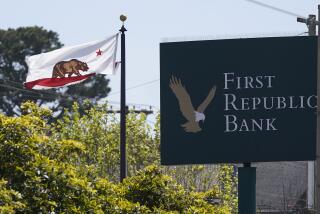Federal officials privately issue banks’ ‘stress tests’ results
- Share via
WASHINGTON — Federal officials on Friday began laying the groundwork for next month’s release of eagerly awaited test results on the nation’s largest banks, publicly explaining the process used to determine if the institutions need more bailout money.
The move came as bank executives on Friday privately learned how they did on the so-called stress tests, designed to determine if the 19 largest institutions could weather a worse-than-expected deepening of the recession.
Banks are not allowed to reveal the results, and the Federal Reserve cautioned Friday that the need for additional capital by a bank “is not a measure of the current solvency or viability of the firm.”
Although the government has not yet identified which banks might need to raise capital, most economists and banking experts believe there will be some. Frederick Cannon, an analyst with Keefe, Bruyette & Woods, has done his own stress tests using criteria similar to the government’s, and he expects several of the 19 will require infusions, including a number of regional banks.
The Obama administration will publicly release the results the week of May 4, though officials are trying to determine how much data to disclose.
But given the emphasis the administration has placed on the tests as the key to future steps to repair the financial system, officials fear that the information might be misinterpreted -- and weaken some of the country’s most important banks. So the Federal Reserve, which is overseeing the tests, released a 21-page white paper explaining the data and assumptions used in the testing to give the public time to understand it, according to a senior Fed official who spoke on condition of anonymity because the process is ongoing.
Treasury Secretary Timothy F. Geithner and Fed officials have stressed that most banks are well capitalized. But if the recession worsens significantly, administration officials worry that some of the largest banks might not have enough money to handle the additional losses they would face.
“One of Treasury’s goals is to prevent investors and depositors from drawing incorrect conclusions” about the results, said Scott Talbott, the chief lobbyist for the Financial Services Roundtable, which represents large financial institutions. “Transparency about the methodology, as well as the assumptions, will avoid that.”
More than 150 senior bank examiners, economists and other officials from three federal bank regulatory agencies spent the last several weeks scouring the books of the 19 U.S. banks with more than $100 billion in assets, including JPMorgan Chase, Citigroup, Bank of America and Wells Fargo. The banks combined hold two-thirds of the assets of the entire U.S. banking system and more than half of the loans.
The stress tests are designed to determine if the banks need to raise more money as a cushion against losses on loans and other investments. If so, they would be given six months to raise it privately before the federal government would step in with additional bailout money to ensure that they would not fail. So far, the 19 banks have gotten about $214 billion in bailout money from the $700-billion rescue fund, and the stress tests could determine if the administration needs to ask Congress to replenish the fund.
Regulators analyzed each bank’s reserves and its possible losses under two scenarios.
The first was based on the consensus of various professional forecasters for economic conditions through the end of 2010. They include the nation’s economic output dropping by 2% this year before rebounding to produce 2.1% growth in 2010, housing prices falling 14% this year and an additional 4% next year and the unemployment rate averaging 8.8% next year.
The second scenario was designed to be a “worse case” that would include “market shocks” similar to what took place in the second half of last year, according to the Fed. The scenario assumes economic output dropping 3.3% this year before rebounding weakly to 0.5% growth in 2010. It assumes that housing prices will plummet 22% this year and a further 7% next year, and that unemployment will average 8.9% this year and 10.3% in 2010. Unemployment in March was 8.5%.
Economist Mark Zandi of Moody’s Economy.com said the scenarios, developed in February, aren’t particularly tough.
“If they really wanted to put them under a stress, they’d use more negative assumptions,” Zandi said. He noted that the first scenario was more optimistic than his projections, and that the worse-case scenario was only slightly worse.
But the Federal Reserve said the adverse scenario was not designed to be the worst possible case, just one that is “severe, but plausible.”
The senior Fed official said regulators and administration officials were still trying to determine how much information from the stress tests to release.
Results of bank regulatory exams normally aren’t publicly released to avoid runs on the banks by depositors and a lack of confidence by investors. But the administration has emphasized the importance of the stress tests, and failure to release enough data could lead to doubts about how well the banks performed.
--
Michael Oneal of the Chicago Tribune contributed to this report.
More to Read
Inside the business of entertainment
The Wide Shot brings you news, analysis and insights on everything from streaming wars to production — and what it all means for the future.
You may occasionally receive promotional content from the Los Angeles Times.











